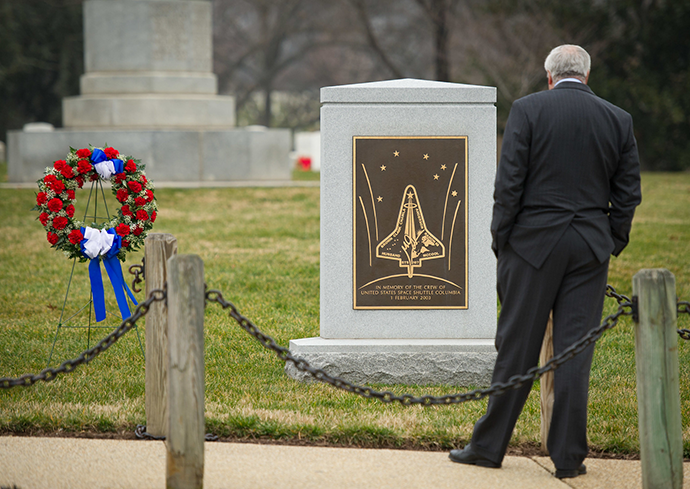The Columbia shuttle was scheduled to land at the John F. Kennedy Space Center in Cape Canaveral, Florida, on the morning of Feb. 1, 2003, after completing a successful 16-day research mission.
Joining the families of the ship’s seven-member crew on the tarmac that morning was alumnus Sean O’Keefe ’78 M.P.A. He was the head of NASA at the time, and says the excitement was palpable.
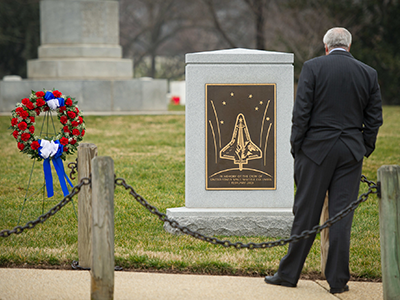
The first orbiter to fly in space with its maiden voyage in 1981, Columbia had drawn international attention for its 28th mission. It brought a sense of optimism following the 9/11 terrorist attacks, and its crew included the first Israeli astronaut.
The landing countdown, which began just before 9 a.m., did not end with the tell-tale sonic booms—made when a shuttle crosses the sound barrier on its return to Earth. “The shuttle was on track to land, but the time came and went, and everybody knew this was not normal,” O’Keefe remembers. “The mood turned from excitement to confusion.”
O’Keefe and others gathered on the landing strip did not know that debris from the shuttle had already begun to rain down across a 200-mile stretch of Texas and Louisiana.
Today, O’Keefe visited the remote town of Hemphill, Texas, where the Columbia crew was recovered. He joined community members and families of the fallen astronauts for a ceremony marking the tragedy’s 20th anniversary.
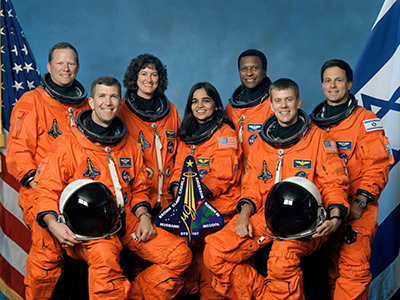
“These are heroic people who’ve shown remarkable resolve and courage in the midst of this despair,” he says.
Last week—on Thursday, Jan. 26—O’Keefe gave remarks at NASA’s annual Day of Remembrance ceremony at the Johnson Space Center in Houston, about 200 miles southwest. Events held the same day at other NASA sites and at Arlington National Cemetery honored Columbia’s fallen and the astronauts who died in the Apollo 1 and Challenger accidents, in 1967 and 1986, respectively.
Most years, O’Keefe attends the remembrance ceremony in Arlington, the final resting place for three Columbia astronauts and home to the Space Shuttle Columbia Memorial. “It always brings back every memory of the day,” he says. “It reminds me why we are responsible for this tragedy. And it provides an occasion to reflect on the experiences.”
So does his work as University Professor and Phanstiel Chair in Leadership at Syracuse University.
‘I don’t hold a lot back’
The Columbia tragedy is part of O’Keefe’s lesson plan at Syracuse University’s Maxwell School of Citizenship and Public Affairs. A University Professor since 2014, he teaches graduate courses in the Department of Public Administration and International Affairs (PAIA). He’s also engaged in Maxwell’s Washington, D.C., programs at the Center for Strategic and International Studies, a think tank where he is a distinguished senior advisor.
“I don’t hold a lot back,” he says of his teaching about the experience. While reliving the tragedy takes a toll, he says it is important, and it “starts with the proposition that on that day we failed.” He adds, “Personally, I failed as a leader to have caught or understood the management dimensions that caused this to happen.”
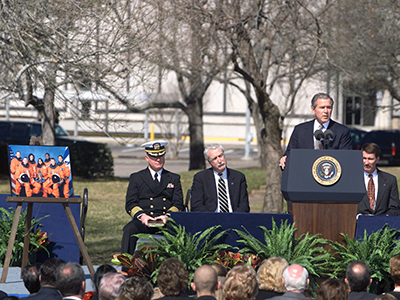
Columbia’s accident was caused by a breach in its left wing inflicted during liftoff by a breakaway chunk of foam insulation. But in its 2003 report, the Columbia Accident Investigation Board cited NASA’s culture as having a contributing role.
That culture was established well before O’Keefe took the helm in late 2001, says O’Keefe’s Maxwell colleague, W. Henry Lambright, professor of political science and public administration and international affairs and director of the Science and Technology Policy Program in the Center for Environmental Policy and Administration. Lambright served as a consultant in the Columbia investigation and has written books and numerous articles about his NASA research.
“The Columbia report says essentially that the accident is rooted in history,” he says, adding that a sense of complacency had gradually arisen from NASA’s previous successes. That was worsened by an atmosphere in which concerns were not aired to the highest levels of management—a common organizational challenge, he adds.
Therein lies one of the most important lessons O’Keefe strives to impart on students: The critical role of organizational dynamics. “If you create a culture that doesn’t particularly tolerate objection or different points of view, it could kill somebody,” he says.
His students also hear lessons about accountability, risk management and crisis response. His invited guest lecturers have included astronauts and other insiders like Michael Lienbach, the former launch director of the space shuttle program at the Kennedy Space Center who played a key role in the Columbia search and recovery effort.
What impacts students the most: O’Keefe’s memories of Columbia’s astronauts.
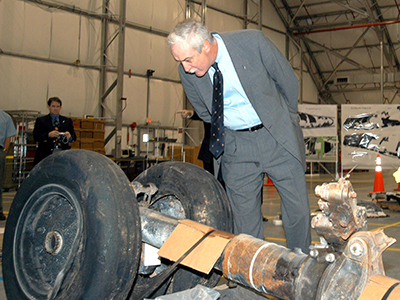
Commander Rick Husband, a married father of two, was an accomplished U.S. Air Force fighter pilot, astronaut and man of faith. Moments before launch on Jan. 16, 2003, he said, “The Lord has blessed us with a beautiful day here. We appreciate all of the hard work everyone has put into this, and we are ready to go.”
In addition to Husband, the crew included Lt. Air Force Col. and payload commander Michael Anderson; Navy commander and pilot William McCool; payload specialist IIan Ramon—the first Israeli astronaut; and mission specialists David Brown, Kalpana Chawla and Laurel Clark. Clark and Brown were doctors in the Navy; Chawla was an engineer.
When sharing details, O’Keefe says there’s “always a moment in which students realize it’s not some conceptual argument—it’s not a theory that has been made example of. These were real people.”
‘Lucky to have him’
Appointed by President George W. Bush, O’Keefe’s first charge at NASA was to eliminate a $5 billion cost overrun in the construction of the international space station.
“His first year at NASA was largely focused on straightening out its finances,” says Lambright.
The Columbia accident happened just over a year into O’Keefe’s tenure. Lambright credits him with providing steady leadership in the months that followed.
“It was to his credit that he kept his composure and followed the operating procedure,” he says. “He was dealing with the media, his own organization, holding meetings with the president, and trying to find out what went wrong—and he was also spending a lot of time with the families.”
Among O’Keefe’s most notable accomplishments, says Lambright, is getting the president’s subsequent endorsement of his plan to return to space with a renewed focus on safety. He also celebrated the spacecraft Cassini’s exploration of Saturn, and the landing of the Mars exploration rovers Spirit and Opportunity.
Back at Syracuse, O’Keefe’s students have benefitted not only from his candid NASA accounts, but also his willingness to share other leadership experiences. He was a presidential appointee four times—his roles before NASA included comptroller for the U.S. Department of Defense, secretary of the Navy and deputy director of the U.S. Office of Management and Budget. After leaving NASA in early 2005, he served as chancellor of Louisiana State University, vice president of the General Electric Co. and chief executive officer of the Airbus Group, Inc.
“There’s no way you can get out of a textbook what he offers—what it feels like to be in charge of a very complicated organization made up of very dedicated and prideful people,” says Lambright.
Maxwell School Dean David M. Van Slyke echoes the sentiment. “Sean’s willingness to discuss the challenges of leadership with both humility and candor make him a forceful presence in the classroom and a favorite among his students,” he says.
Van Slyke serves as the Louis A. Bantle Professor of Business and Government Policy, a position held by O’Keefe when he first taught at Maxwell in the years leading up to his NASA appointment. At the time, O’Keefe was also founding director of Maxwell’s National Security Studies Program. When he returned in 2014, he became the 17th faculty member at Syracuse to receive the prestigious appointment of University Professor and he was concurrently named Phanstiel Chair at Maxwell. He also serves on the board of the University’s D’Aniello Institute for Veterans and Military Families.
For the families
O’Keefe’s dedication to the legacy of Columbia’s fallen is fueled by an earlier NASA tragedy and by the example set by the president.
Early in his tenure, O’Keefe learned that the astronauts who died in the Challenger shuttle explosion—including teacher Christa McAuliffe—had not posthumously received the Congressional Space Medal of Honor for which they’d been nominated years earlier. Their families were largely estranged from NASA.
O’Keefe invited them to meet with him and receive the long overdue space medals—ironically, just days after Columbia’s liftoff. The gathering started with an apology.
The somber meeting left a “searing impression,” he says. “They had been largely left on their own to work through the emotional trauma of this tragedy.”
He thought of them, just over a week later, when it became clear that Columbia was not coming home.
O’Keefe spoke with then-President George W. Bush that morning. “The very first thing he asked me when I called him a half hour after the accident happened, was, ‘Where are the families?’” says O’Keefe. “We spent a lot of time talking about all kinds of things in the weeks and months that followed, but to him there was never anything that rose to a higher level than how the families were being cared for.”
O’Keefe also considers a conversation he had with Evelyn Husband, widow of Columbia Commander Rick Husband. “She left me with the clear understanding that NASA’s job was to go find out what happened, go fix it and rededicate ourselves to the mission of exploration that they gave their lives to,” he says.
She and other family members of Columbia’s fallen wanted assurance that their loss had meaning—”that something was derived from the horrible tragedy,” says O’Keefe. “I made it a point for them to know we were going to treat it that way. We owed them that diligence.”
For the full story, visit the Maxwell School website.
